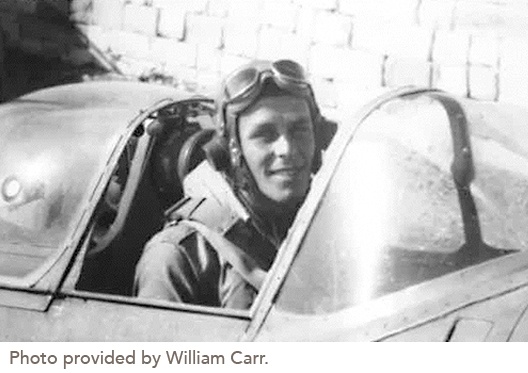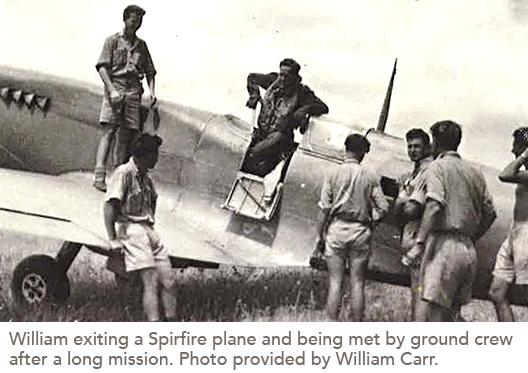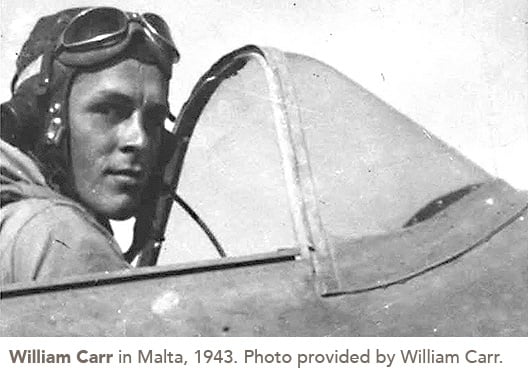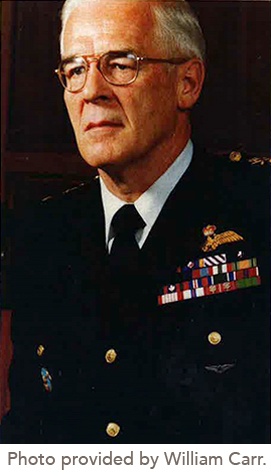 The shell exploded.
The shell exploded.
Thirty-thousand feet above the ground, William Carr’s plane rocked violently as the anti-aircraft shell exploded just under his seat. Though he was not yet 22, he was certain he was going to die. A pilot in the Royale Canadian Air Force, William was flying in enemy airspace over Siena, Italy. The explosion had smashed the oil cooler radiator on the lower surface of the wing, and the plane was leaking oil.
“The loss of oil pressure in the engine made it certain failure would happen,” William said. “I put my hand under the seat, because the explosion had been there, and I pulled it out and there was some blood on my hand.”
For one horrible moment, he was certain that not only was the plane about to fall out of the sky, but that he was seriously wounded as well. He quickly realized he was still in control of the plane, and later discovered what was hanging below his seat was actually his ruined parachute and not part of his anatomy.
“The blood later proved to be a minor wound in the bum,” William said.
But with his parachute in tatters, there would be no escaping if the plane failed. He was going to have to fly back to base and land safely if he wanted to survive.
Home base was about 500 km away. The flight took over an hour.
“I made it, even though I had no oil in the engine, it kept on,” he said. “I survived.”
Within a few days, William was back in the air.
Born in Grand Bank Newfoundland on St. Patrick’s Day 1923, William joined the air force at the age of 18. He had just gotten his Bachelor of Arts and Commerce degree from Mount Allison University in New Brunswick, and felt it was his duty to help the war effort.
“I joined because of the war, we all joined because of the war. It was our duty,” he said.
 During the war, William flew photo reconnaissance in a Spitfire plane. Unlike other planes in the war, Spitfires designed for photo reconnaissance did not have guns, armour or bullet-proof glass. Some did not have radios, and if they did they were expected to maintain radio silence, leaving the pilot very-much alone on a mission that could last up to seven hours. Spitfires were single-engine propeller planes designed to fly faster and higher than any other. They could reach speeds of over 630 km/h, and flew at an altitude of about 10,000 meters. Seventy-six years later, today’s commercial planes usually fly at about 869 km/h and at an altitude between 11-12,000 meters.
During the war, William flew photo reconnaissance in a Spitfire plane. Unlike other planes in the war, Spitfires designed for photo reconnaissance did not have guns, armour or bullet-proof glass. Some did not have radios, and if they did they were expected to maintain radio silence, leaving the pilot very-much alone on a mission that could last up to seven hours. Spitfires were single-engine propeller planes designed to fly faster and higher than any other. They could reach speeds of over 630 km/h, and flew at an altitude of about 10,000 meters. Seventy-six years later, today’s commercial planes usually fly at about 869 km/h and at an altitude between 11-12,000 meters.
“Looking back on it, you wonder…” William said. He went on to speak about the time he was asked to fly out to Malta, a small island off the coast of Italy, from Oxford, England.
 He was to fly there via Gibraltar. The nearly 5,000 km trip took him three days. “Well that’s a hell of a long way in a single-engine airplane… and looking back on it, I was 19 years old. I was told to work-up an airplane and fly it to Malta, and that was the extent of the briefing I was given. That’s the way it was. I did what I was told and I went to Malta,” he said.
He was to fly there via Gibraltar. The nearly 5,000 km trip took him three days. “Well that’s a hell of a long way in a single-engine airplane… and looking back on it, I was 19 years old. I was told to work-up an airplane and fly it to Malta, and that was the extent of the briefing I was given. That’s the way it was. I did what I was told and I went to Malta,” he said.
By the time he was 22, William had flown 142 Spitfire missions over Nazi-occupied Europe. In 1944, he was awarded the Distinguished Flying Cross for his efforts.
Mapping the Canadian North
In the summer of 1945, William was sent to help map the Canadian north, knowing that at any time he could be called to fly east and fight against the Japanese. At the time, more than half of Canada’s north was unmapped.
“Many of our… aeronautical charts were pages with little or no topographic detail, but with horizontal and vertical lines printed on them to indicate Latitude and Longitude,” he wrote in an article published by Vintage Wings of Canada titled ‘A Lake Called Victory’. “Coupled to this lack of navigation help was the decreased reliability of magnetic compasses as one headed north toward the Magnetic Pole.”
It was hard memory work and took a certain knack, according to William. He knew of a few people getting lost while mapping.
William and a group of other Royal Canadian Air Force pilots flew float-equipped Norseman aircraft, which were more of a work-horse than a speed devil, like the Spitfire. Most of the time, William was alone in the plane, only surveillance equipment for company, but at least no one was shooting at him.
“It made me realize what a vast and beautiful country we live in, and made us realize how little we knew about it,” he said.
“It was all new. You’re young, and it was exciting,” William said. “I think I was very lucky to have the opportunities to do the things I was able to do.”
There was a main base camp, where supplies were replenished and a powerful HF radio station was maintained by ground crew. William’s job was to survey the surrounding area, looking for a lake big enough for him to land on. He would then bring the surveying crew there, where they could do their observations.(1) He never imagined that one of those lakes would later be named after him: Carr Lake.
“Thinking back, it is a wonder to think how isolated we really were and how little we realized it or worried about it,” he wrote.(1)
On August 15, 1945, William woke up to news that would change everything.
“The BBC’s shortwave News service came in loud and clear, but much to my surprise, the BBC’s usual staid reporting was missing and a very voluble and excited announcer was talking about the surrender of the Japanese.”(1)
He quickly woke the surveyors in their tent, who, due to their late-night work, had slept in. From then on, the lake they had camped on would be known as Victory Lake.(1)
World War II was over. It had claimed the lives of over 17,000 airmen and women in the Royale Canadian Air Force.
“I guess a lot of us, subconsciously, were relieved that you made it [out of the war], because a lot of your buddies didn’t,” he said.
William would spend two more summers surveying the Canadian North.
 Peace Time: Piloting the Queen, Leading the Air Force, and Earning an Honourary Doctorate at 93.
Peace Time: Piloting the Queen, Leading the Air Force, and Earning an Honourary Doctorate at 93.
After the war, William was offered a full-time position with the air force and decided to stay. He continued to practice photo mapping. He also flew delegates, including Her Majesty, Queen Elizabeth II, Princess Margaret, Charles De Gaulle and Prime Minister Diefenbaker.
While at the Air Force, he got his Master of Science Degree at the Rochester Institute of Technology in 1949.
In 1960 he established the United Nations Air Transport Operation in the Congo, which was a huge UN peacekeeping mission during the Cold War. In 1974, at the age of 51, he was promoted to the rank of Lieutenant-General, and the following year he helped establish Air Command and became its first commander.
William retired from the military in 1978, and immediately became a vice-president of Canadair and Bombardier. He worked as a marketer, selling airplanes around the world, and is credited with helping to save the aerospace industry, a feat he is particularly proud of, and for which he won a C.D. Howe Award.
“I’m very grateful I had the opportunities I had,” he said. “I particularly enjoyed my peace time employment with Bombardier and selling airplanes around the world.”
An extraordinary Canadian, some of William’s many accolades include: the Venerable Order of Saint John, Commander of the Order of Military Merit, the Legion of Merit, and induction into the Veterans Hall of Honour.
He has been inducted into Canada’s Aviation Hall of Fame and is widely considered the father of the modern Canadian air force.
Now 93, Lieutenant-General William Kier Carr continues to achieve extraordinary things. While at his retirement residence in Kanata, he received the news of having been awarded an honourary doctorate of law from Memorial University “for his achievements in both military and civil aviation, along with his proven leadership and organizational abilities and their outstanding benefit to Canada” (2)
Although he wasn’t able to attend the service, William said he “felt humbly honoured” about receiving the honourary doctorate. “I’ve won awards before, but this is particularly humbling at my age,” he said.
“Memorial will always respect and remember the legacy of [William’s] generation, and those who went before,” said Annette Staveley, deputy public orator at Memorial University, who gave a speech at William’s convocation. “…In our minds we can simultaneously conjure that day in 1942 when… Billy Bishop, awarded William Carr his wings; and today, in 2016, a mere 74 years later, we can salute William Kier Carr and vow that At the going down of the sun and in the morning we shall remember him, and all, who like him, inspire this new generation of graduates to take up the fight against ignorance, hatred and violence in our century.”
(1) Carr, William Kier. "A Lake Called Victory Vintage Wings of Canada." A Lake Called Victory Vintage Wings of Canada. Vintage Wings of Canada, n.d. Web. 21 July 2016.
(2) Cook, Mandy. "University Gathering." Gazette Memorial University of Newfoundland. Memorial University Gazette, 08 Apr. 2016. Web. 22 July 2016. https://gazette.mun.ca/student-life/university-gathering/
To learn more about General Carr, click on one of the stories below.
- His indoctrination into Canada’s Aviation Hall of Fame: http://www.vintagewings.ca/VintageNews/Stories/tabid/116/articleType/ArticleView/articleId/441/Honouring-Bill-Carr.aspx
- The Memory Project: http://www.thememoryproject.com/stories/2722:william-carr/
- His time surveying the Canadian North: http://www.vintagewings.ca/VintageNews/Stories/tabid/116/articleType/ArticleView/articleId/570/A-Lake-Called-Victory.aspx

.jpg)
